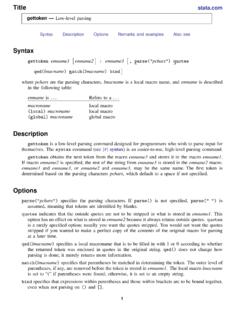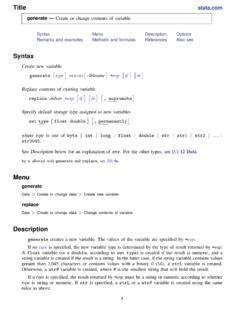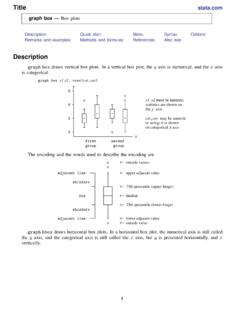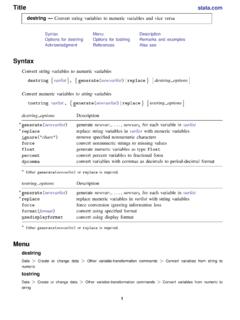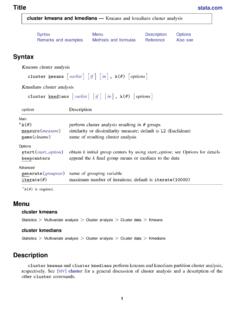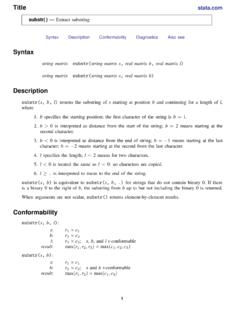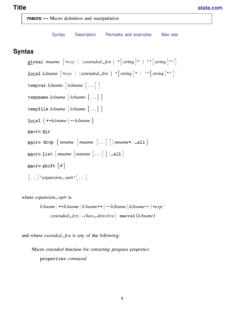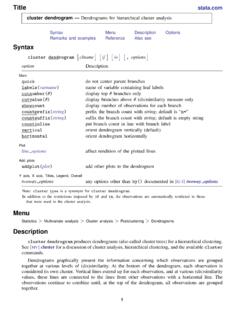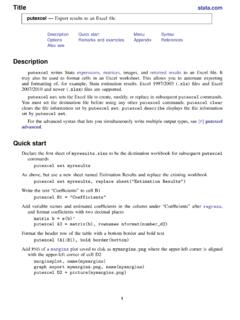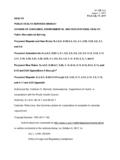Transcription of Title stata
1 Options for specifying the look of special areasSyntaxDescriptionOptionsRemarks and examplesAlso seeSyntaxareaoptionsDescriptioncolor(col orstyle)outline and fill colorfcolor(colorstyle)fill colorfintensity(intensitystyle)fill intensitylcolor(colorstyle)outline colorlwidth(linewidthstyle)thickness of outlinelpattern(linepatternstyle)outline pattern (solid, dashed, etc.)lstyle(linestyle)overall look of outlineastyle(areastyle)overall look of area, all settings abovepstyle(pstyle)overall plot style, including areastylerecast(newplottype)advanced; treat plot asnewplottypeSee [G-4]colorstyle, [G-4]intensitystyle, [G-4]linewidthstyle, [G-4]linepatternstyle, [G-4]linestyle,[G-4]areastyle, [G-4]pstyle, and [G-3] options aremerged-implicit; see [G-4]concept: repeated the look of, for instance, the areas created bytwoway area(see[G-2]graph twoway area) or the rectangles used bygraph dot(see [G-2]graph twoway dot).
2 Theareaoptionsand thebarlookoptions(see [G-3]barlookoptions) are synonymous when usedongraph twoway(see [G-2]graph twoway) and may be used (colorstyle)specifies one color to be used both to outline the shape of the area and to fill itsinterior. See [G-4]colorstylefor a list of color (colorstyle)specifies the color to be used to fill the interior of the area. See [G-4]colorstylefor a list of color (intensitystyle)specifies the intensity of the color used to fill the interior of the [G-4]intensitystylefor a list of intensity (colorstyle)specifies the color to be used to outline the area. See [G-4]colorstylefor a listof color (linewidthstyle)specifies the thickness of the line to be used to outline the area. See[G-4]linewidthstylefor a list of (linepatternstyle)specifies whether the line used to outline the area is solid, dashed, [G-4]linepatternstylefor a list of pattern Options for specifying the look of special areaslstyle(linestyle)specifies the overall style of the line used to outline the area, including its pattern(solid, dashed, etc.)
3 , thickness, and color. The three options listed above allow you to change theline s attributes, butlstyle()is the starting point. See [G-4]linestylefor a list of (areastyle)specifies the overall look of the area. The options listed above allow you to changeeach attribute, butstyle()provides a starting need not specifystyle()just because there is something you want to change. You specifystyle()when another style exists that is exactly what you desire or when another style wouldallow you to specify fewer changes to obtain what you [G-4]areastylefor a list of available area (pstyle)specifies the overall style of the plot, including not only theareastyle, but also allother settings for the look of the plot. Only theareastyleaffects the look of areas. See [G-4]pstylefor a list of available plot (newplottype)is an advanced option allowing the plot to be recast from one type to another,for example, from an area plot to a line plot; see [G-3]advancedoptions.
4 Most, but not all, plotsallowrecast().Remarks and are presented under the following headings:Use with twowayUse with graph dotUse with twowayareaoptionsare allowed as options with anygraph twowayplottype that creates shaded areas,for example,graph twoway areaandgraph twoway rarea, as in. graph twoway areayvar xvar, color(blue)The above would set the area enclosed byyvarand thexaxis to be blue; see [G-2]graph twowayareaand [G-2]graph twoway (),lwidth(),lpattern(), andlstyle()options are also used to specify howplotted lines and spikes look for all ofgraph twoway s range plots, paired-coordinate plots, and forarea plots, bar plots, spike plots, and dropline plots. For example,. graph twoway rspikey1var y2var xvar, lcolor(red)will set the color of the horizontal spikes between values ofy1varandy2varto with graph dotIf you specifygraph dot slinetype(rectangle)option, the dot chart will be drawn withrectangles substituted for the dots.
5 Then theareaoptionsdetermine the look of the rectangle. Theareaoptionsare specified insidegraph dot srectangles()option:. graph dot..,..linetype(rectangle) rectangles(area_options)..If, for instance, you wanted to make the rectangles green, you could specify. graph dot..,..linetype(rectangle) rectangles(fcolor(green))..See [G-2]graph Options for specifying the look of special areas 3 Also see[G-2]graph dot Dot charts (summary statistics)
